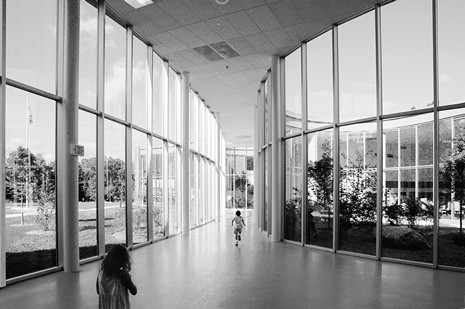Description
Two issues which frequently emerge when consulting with school communities are firstly the issue of physical connections between different departmental areas, which is a staff concern and secondly the desire for buildings with more expressive freeform plans featuring circles and other organic shapes to make the experience of education more fun; this latter issue is usually raised by pupils. These two competing aims are usually in direct conflict with each other.
At the Burr Elementary School, the designers have managed to address both wishes in this distinctive new school building. From a distance, the form is a double-height rectangular block (with some upper mezzanine levels), evoking a smart, highly glazed factory unit on a green field site. However, on closer scrutiny the basic form is given an exciting twist by the introduction of curved semi-oval cutouts, one at the back car park side, the other is a much larger bite on the south side. They both form entrance courts. There are four other amoeboid cutouts which act as light wells within the rectangular plan form. This creates a distinctive architecture full of natural light without sacrificing the essential functional coherence of the school’s layout.
Organisation then follows the logic of a rectangular plan form with conventional square classrooms running along either side of the block and communal spaces such as the gym, cafeteria and auditorium sandwiched between them. The light well cutouts create spatial drama and help to structure the plan in a very particular way. They are organising devices, related spaces are clustered around a science bubble, a music bubble and a social (cafeteria) bubble. Negative and positive forms then jostle with each other being either external voids or internal rooms. Yet the intimacy of the courtyard shape develops an intriguing sense of spatial ambivalence, where one becomes uncertain as to what is outside and what is inside. Another positive payback is that the spaces between, the interstitial circulation areas, have a similarly interesting form which is a refreshing contrast to the usual straight run of internal corridors in many schools with this plan form.
The 6 hectare site covered with oak, maple and tulip trees is the kind of woodland that is disappearing as a result of suburban sprawl which in turn necessitates the need for a school. The integration of nature into the form of the building is one of the key conceptual ideas. Existing and new trees bubble up through the school building itself, manifesting nature within the courtyards. The north and south walls are made of rough concrete blocks with rustication in the form of bubbles cut into the surfaces. In the reception area, a long curved bench is made of rough local rock. This pays respect to the natural setting, its history, a nod to the American dream itself.
Drawings
Photos
 View of entrance court with rusticated wall in foreground
View of entrance court with rusticated wall in foreground
 Corridor between the courtyards
Corridor between the courtyards
Originally published in: Mark Dudek, Schools and Kindergartens: A Design Manual, Birkhäuser, 2015.